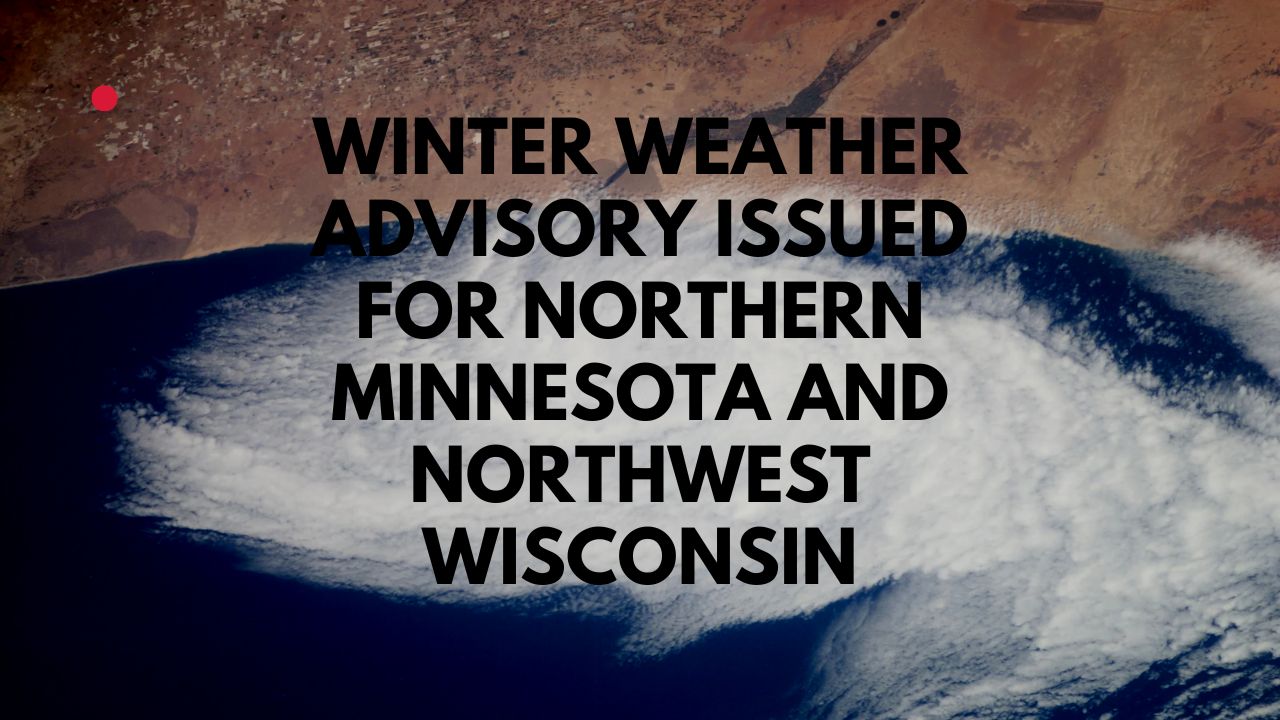NEWS
Winter Weather Advisory Issued for Northern Minnesota and Northwest Wisconsin 007

Introduction to Winter Weather Advisory Issued for Northern Minnesota and Northwest Wisconsin 007
A comprehensive guide to understanding the Winter Weather Advisory issued for Northern Minnesota and Northwest Wisconsin, including expected weather conditions, safety precautions, and regional impact.
Winter is here, and for residents of northern Minnesota and northwest Wisconsin, this means Winter Weather Advisory Issued for Northern Minnesota and Northwest Wisconsin bracing for chilling winds, heavy snowfall, and the occasional blizzard. The recent winter weather advisory highlights the importance of staying prepared and informed. Whether you’re a local resident or an outdoor enthusiast, understanding how to handle these conditions is crucial. In this blog post, we’ll explore the advisory’s implications, provide practical tips for preparation, and offer resources to help you stay safe and connected.
What is a Winter Weather Advisory?
Winter Weather Advisory Issued for Northern Minnesota and Northwest Wisconsin Service to inform the public about potentially dangerous winter weather conditions. These advisories typically indicate that the weather could significantly impact daily activities and travel. For northern Minnesota and northwest Wisconsin, this often means heavy snowfall, icy roads, and reduced visibility.
The Impact on Daily Activities
Winter Weather Advisory Issued for Northern Minnesota and Northwest Wisconsin can disrupt daily routines. Schools may close, public transportation can be delayed, and roads become hazardous. It’s essential to stay updated with local news and weather reports to plan your day accordingly. Make sure to check for school closures or delays and consider working from home if possible.
Outdoor Plans on Hold
For outdoor enthusiasts, a Winter Weather Advisory Issued for Northern Minnesota and Northwest Wisconsincan put a damper on plans. Whether it’s skiing, snowmobiling, or simply hiking through the woods, extreme weather conditions pose significant risks. Always check the latest weather updates and trail conditions before heading out, and be prepared to adjust your plans to ensure your safety.
Staying Safe During a Winter Weather Advisory
Preparing Your Home
Preparing your home for a Winter Weather Advisory Issued for Northern Minnesota and Northwest Wisconsin is essential. Make sure to have an adequate supply of heating fuel and consider investing in a backup generator to provide power in case of outages. Insulate your pipes to prevent freezing, and seal any drafts around windows and doors to keep the cold air out. Stock up on essential supplies, such as non-perishable food, bottled water, batteries, and a first-aid kit to ensure you’re well-prepared for any emergency.
Vehicle Preparedness
Your vehicle should also be ready for winter conditions. Equip your car with snow tires and keep an emergency kit in the trunk, which should include blankets, a flashlight, a shovel, ice scrapers, and sand or kitty litter for traction. Ensure that your gas tank is full and that your car’s maintenance is up to date. Before heading out, always check the latest road conditions and allow extra time for travel.
Staying Informed
Stay informed about the latest Winter Weather Advisory Issued for Northern Minnesota and Northwest Wisconsin by tuning into local news, radio stations, or using weather apps. Sign up for community alert systems to receive real-time notifications about severe weather in your area. Being informed will help you make timely decisions and avoid unnecessary risks during a winter weather advisory.
Outdoor Safety Tips
If you must venture outdoors during a Winter Weather Advisory Issued for Northern Minnesota and Northwest Wisconsin, dress appropriately in layers, including a waterproof outer layer to protect against snow and wind. Use thermal socks, insulated gloves, and a hat to retain body heat. Stay on marked paths and trails, and let someone know your planned route and expected return time. Carry a fully charged mobile phone and a GPS device if you’re heading into remote areas.
Community Support and Resources
Don’t hesitate to reach out to Winter Weather Advisory Issued for Northern Minnesota and Northwest Wisconsin for assistance during extreme winter weather. Many areas have support networks to help with shoveling driveways, delivering groceries, or providing shelter. Knowing your community resources can be a lifeline during severe winter conditions.
By taking these precautions and staying informed, you can safeguard yourself and your loved ones during a winter weather advisory in northern Minnesota and northwest Wisconsin.
Preparing for Winter Storms
Home Preparation and Safety Measures
When a winter storm is on the horizon, preparation is key. Here are some tips to ensure your home is ready:
- Stock Up on Essentials
Ensure you have enough food, water, and other essentials to last several days. Don’t forget items like prescription medications, baby supplies, and pet food.
- Inspect Your Heating System
Have your heating system checked by a professional to ensure it’s working efficiently. Also, consider alternative heating sources like space heaters, but use them safely.
- Prepare for Power Outages
Winter storms can lead to power outages. Keep flashlights, extra batteries, and a battery-operated radio on hand. A generator can also be a valuable investment for prolonged outages.
Planning Outdoor Activities During Winter Storms
Venturing outdoors during a winter storm requires careful planning. Here are some tips to help you stay safe:
- Dress in Layers
Wearing multiple layers of clothing helps retain body heat. Choose moisture-wicking materials for inner layers and windproof, waterproof fabrics for outer layers.
- Know Your Limits
Recognize when conditions are too dangerous. If the weather is severe, it’s best to stay indoors and avoid unnecessary risks.
- Gear Up Properly
Ensure you have the right gear for winter activities. This includes insulated boots, gloves, hats, and goggles. Carry a fully charged phone and a map in case you lose your way.
Community Resources and Support
Local Emergency Services and Support Networks
During Winter Weather Advisory Issued for Northern Minnesota and Northwest Wisconsin events, local emergency services and support networks play a crucial role in keeping the community safe. Familiarize yourself with these resources:
- Local Emergency Contacts
Keep a list of important phone numbers, including local police, fire departments, and medical facilities.
- Shelters and Warming Centers
Identify nearby shelters and warming centers in case you need to evacuate your home or seek warmth.
- Community Support Groups
Winter Weather Advisory Issued for Northern Minnesota and Northwest Wisconsin have support groups that offer assistance during winter storms. This can include help with shoveling snow, providing warm meals, or checking on vulnerable neighbors.
Staying Informed and Connected
Staying informed and connected during a Winter Weather Advisory Issued for Northern Minnesota and Northwest Wisconsin advisory is vital. Here are some ways to ensure you receive the latest updates:
- Weather Apps and Alerts
Download reliable Winter Weather Advisory Issued for Northern Minnesota and Northwest Wisconsin apps that send push notifications about severe weather conditions. Set up alerts to stay informed about changes.
- Social Media and Local News
Follow local Winter Weather Advisory Issued for Northern Minnesota and Northwest Wisconsin and emergency services on social media for real-time updates. Many communities also have neighborhood groups that share information and support.
- Emergency Radio Stations
In case of power outages, battery-operated radios can provide crucial information. Know the emergency radio stations in your area.
Winter Safety Recap
Key Takeaways for Winter Preparedness
As winter approaches Winter Weather Advisory Issued for Northern Minnesota and Northwest Wisconsin, it’s crucial to be well-prepared for the challenges associated with harsh weather conditions, Winter Weather Advisory Issued for Northern Minnesota and Northwest Wisconsin. The following key points summarize the essential measures for staying safe:
- Vehicle Readiness
- Equip your car with snow tires and an emergency kit.
- Ensure your gas tank is full and car maintenance is up to date.
- Check road conditions before traveling and allow extra time for journeys.
- Stay Informed
- Tune into local news, radio stations, or use weather apps for updates.
- Sign up for community alert systems for real-time notifications.
- Staying informed aids in making timely and safe decisions.
Home and Personal Safety Measures
To ensure your home and personal safety during winter storms, consider the following precautions:
- Home Preparation
- Stock up on food, water, and other essentials.
- Have your heating system inspected and consider alternative heating sources.
- Be prepared for power outages with flashlights, batteries, and a generator.
- Personal Safety
- Dress in layers with waterproof outerwear.
- Keep thermal socks, insulated gloves, and a hat to retain body heat.
- Use proper gear like insulated boots, gloves, and goggles.
Community Resources and Connections
Leveraging community resources and Winter Weather Advisory Issued for Northern Minnesota and Northwest Wisconsin can make a significant difference during severe winter weather. Here are some important points:
- Local Emergency Services
- Keep a list of emergency contacts including local police, fire departments, and medical facilities.
- Identify nearby shelters and warming centers.
- Community Support
- Many communities offer support networks for assistance with tasks like shoveling snow and delivering groceries.
- Join local support groups to foster community resilience and support vulnerable neighbors.
By adhering to these guidelines and staying vigilant, you can navigate winter weather advisories safely and effectively, ensuring the wellbeing of yourself and your community.
Future Upgradation for Winter Preparedness, Winter Weather Advisory Issued for Northern Minnesota and Northwest Wisconsin
Advanced Heating Systems
Upgrading to advanced heating systems can enhance your Winter Weather Advisory Issued for Northern Minnesota and Northwest Wisconsin readiness significantly. Modern heating solutions, such as geothermal heat pumps or energy-efficient furnaces, provide better warmth and reduce energy consumption. Smart thermostats can also be integrated to regulate temperature more efficiently and be controlled remotely.
Insulation Improvements
Proper insulation is key to maintaining a warm home during winter. Consider upgrading your home’s insulation by adding more to attics, walls, and floors. High-quality, energy-efficient windows and doors can prevent heat loss and drafts, ensuring a more comfortable indoor environment.
Backup Power Solutions
Investing in robust backup power solutions can mitigate the impact of power outages. Home generators, whether portable or standby, ensure your home remains powered during severe weather. Solar power systems with battery storage are another sustainable and reliable option for continuous energy supply.
Smart Home Integration
Integrating smart home technology can enhance winter preparedness. Smart sensors can detect temperature changes and potential issues like frozen pipes. Automated lighting and security systems ensure safety and convenience, even during power disruptions.
Snow Removal Equipment
Upgrading snow removal equipment can make a significant difference in efficiency and safety. High-performance snow blowers and electric snow shovels can clear driveways and walkways quickly. Additionally, installing heated driveway systems can prevent snow accumulation and reduce the need for manual snow removal.
Community Emergency Plans
Encouraging community emergency plans and regular drills can improve collective preparedness. Developing detailed strategies for different winter scenarios ensures everyone knows their roles and responsibilities. Establishing communication channels within the community can provide timely assistance and support to those in need.
By considering these upgrades and innovations by Winter Weather Advisory Issued for Northern Minnesota and Northwest Wisconsin, you can significantly enhance your winter preparedness, ensuring not only safety but also comfort and resilience during the harshest weather conditions.
Conclusion
Navigating Winter Weather Advisory Issued for Northern Minnesota and Northwest Wisconsin advisories can be challenging, but by staying informed and prepared, you can minimize the risks and disruptions to your daily life. Remember to keep your home stocked with essentials, ensure your heating system is running efficiently, and plan for potential power outages. When it comes to outdoor activities, dress appropriately, know your limits, and always check the latest weather updates before heading out.
Utilize community resources and emergency services to stay connected and supported during severe weather events. By taking these steps, you can keep yourself and your loved ones safe while enjoying the winter season. Stay vigilant, stay prepared, and embrace the winter months with confidence and care. For continued updates and more winter safety tips, be sure to visit our website and sign up for our newsletter.
FAQs
What should I include in my emergency kit for a winter storm?
Your emergency kit should have enough supplies to last several days. Key items include:
- Non-perishable food and bottled water
- Prescription medications and basic first aid supplies
- Battery-operated or hand-crank radio
- Flashlights and extra batteries
- Warm clothing and blankets
- Personal hygiene items
- Important documents in waterproof packaging
- Pet food and supplies if you have pets
How can I prevent pipes from freezing during a winter storm?
To prevent pipes from freezing, insulate exposed pipes and keep a trickle of water running through faucets. Open cabinet doors under sinks to allow warm air to circulate around pipes. If you plan to be away from home, keep the thermostat set to at least 55°F (13°C).
Can I use a generator during a winter storm, Winter Weather Advisory Issued for Northern Minnesota and Northwest Wisconsin?
Yes, a generator can be very useful during power outages caused by winter storms. Ensure it is placed outside, away from windows, doors, and vents to avoid carbon monoxide poisoning. Follow the manufacturer’s instructions for safe use.
What are the signs of hypothermia and frostbite?
Hypothermia symptoms include shivering, exhaustion, confusion, fumbling hands, memory loss, slurred speech, and drowsiness. Frostbite can cause a loss of feeling and color in affected areas, such as fingers, toes, nose, and ears. Skin may become white, grayish-yellow, or hard and waxy. Seek medical attention immediately if you suspect hypothermia or frostbite.
Is it safe to travel during a winter weather Winter Weather Advisory Issued for Northern Minnesota and Northwest Wisconsin?
Traveling during a winter weather advisory is generally not recommended due to hazardous conditions. If travel is necessary, ensure your vehicle is winterized and carry an emergency kit. Check real-time weather updates, keep your gas tank full, and let someone know your travel plans.
How can I stay connected with my community during a winter storm?
Stay connected by following Winter Weather Advisory Issued for Northern Minnesota and Northwest Wisconsin and emergency services on social media. Join neighborhood groups that share important information and resources. Keep your phone charged and have a battery-operated radio for updates in case of power outages.
What should I do if I lose power during a winter storm?
If you lose power, first report the outage to your utility company. Use flashlights instead of candles to reduce the risk of fire. Keep refrigerator and freezer doors closed to preserve food. Dress warmly and use layers of blankets to stay warm. If using a generator, follow safety guidelines.
By keeping these FAQs in mind, you can better prepare for winter storms and ensure your safety and well-being during severe weather events. For more detailed information and additional resources, visit our website and sign up for our newsletter.
NEWS
The Chaleur Ship Sink: Navigating Lessons in Maritime History

The sea has always been a cradle of mystery and adventure, beckoning sailors to explore its vast expanse while reminding them of its unforgiving nature. Among the tales of the ocean, the story of the The Chaleur Ship Sink is a testament to human endeavor and vulnerability. This post dives into the events surrounding the Chaleur, offering maritime enthusiasts, disaster preparedness communities, and environmental activists a detailed exploration of its legacy.
Introduction to The Chaleur Ship Sink
The Chaleur ship once heralded for its technological advancements and robust design, met an unexpected fate that still reverberates through maritime history. Its sinking is more than just a maritime mishap; it is a crucial chapter that underscores the unpredictable power of nature and the limits of human engineering. This blog post aims to dissect the Chaleur ship’s story, from the incident itself to its broader implications on maritime safety and environmental stewardship.
Brief Overview of the Chaleur Ship and Its Significance to Maritime History
The Chaleur was not just another ship; it was a symbol of innovation in maritime design. Built for resilience and efficiency, it was celebrated for its state-of-the-art navigation systems and sturdy construction. Its routes connected vital economic zones, making it a linchpin for the local economy. However, the ship’s sudden sinking shocked maritime communities worldwide, prompting a reevaluation of safety norms and environmental considerations.
The Chaleur Ship Sink
Detailed Account of the Incident
In the early hours of a fateful morning, the Chaleur ship encountered treacherous conditions that tested its capabilities. A confluence of unforeseen circumstances, including severe weather and technical malfunctions, led to its rapid descent beneath the waves. Crew members fought valiantly, but the overwhelming forces of nature proved insurmountable.
Eyewitness accounts from surviving crew and rescue teams paint a vivid picture of the chaos and urgency of those moments. Alarms blared as the ship’s hull breached, and water rushed into compartments meant to be watertight. In less than an hour, the Chaleur was swallowed by the sea, leaving only debris and unanswered questions in its wake.
Analysis of the Factors Leading to the Sink
Several factors contributed to the Chaleur’s demise. First, the ship’s navigation systems failed to accurately predict the severity of the weather. High-speed winds and towering waves exceeded the ship’s design limits. Additionally, an investigation revealed a critical weakness in the hull that had gone unnoticed during routine inspections.
Human error also played a role. Decisions made under stress can often lead to mistakes, and the Chaleur’s crew was no exception. Miscommunications and delayed responses compounded the crisis, ultimately sealing the ship’s fate. This tragic incident highlighted the need for comprehensive training and robust communication protocols in maritime operations.
Impact on the Local Maritime Community and Economy
The Chaleur ship sink sent ripples through the local maritime community and economy. The ship was a vital link in supply chains, transporting goods that fueled regional markets. Its absence created logistical challenges and economic shortfalls, affecting businesses that relied on its deliveries.
Families of the crew faced emotional and financial hardships, prompting local authorities and charities to step in with support programs. The community’s response showcased resilience and solidarity, yet the incident underscored vulnerabilities that remained unaddressed.
Response and Recovery Efforts
Immediate Response Strategies and Challenges Faced
Reacting swiftly to the Chaleur ship sink, rescue operations were launched to save survivors and recover the vessel. However, these efforts were fraught with challenges. The harsh weather conditions that contributed to the sinking persisted, hampering visibility and endangering rescue teams.
Coordination among various rescue organizations was necessary but difficult to achieve. Differing protocols and resource constraints slowed the operation, highlighting the need for a unified emergency response framework in maritime incidents.
Long-term Recovery Plans and Successes
In the wake of initial response efforts, long-term recovery plans were set into motion. These included environmental assessments to gauge the impact of spills and debris on marine ecosystems. Clean-up operations were undertaken to remove pollutants and salvage the ship’s remnants.
A concerted effort to restore affected marine habitats was initiated, involving biologists and environmental organizations. Over time, these recovery programs saw significant successes, rejuvenating ecosystems that had suffered in the wake of the Chaleur’s sinking.
Lessons Learned and Future Implications
Insights Gained from the Incident for Maritime Safety
The Chaleur ship sink left an indelible mark on maritime safety protocols. Investigations into the incident led to recommendations for more stringent inspections of critical ship components. The importance of redundancy in navigation systems was also emphasized, ensuring that ships could operate safely even if primary systems failed.
Training programs were revamped to incorporate real-world scenarios, enabling crews to practice crisis management skills in controlled environments. These measures aimed to prevent similar incidents by equipping maritime professionals with the knowledge and tools to handle emergencies effectively.
Environmental Impact and Efforts for Restoration
The environmental implications of the Chaleur ship sink were profound. Oil spills and debris posed significant threats to marine life, prompting immediate and ongoing restoration efforts. These efforts focused on cleaning affected areas and rehabilitating wildlife impacted by the incident.
Environmental activists played a critical role, advocating for stricter regulations on ship construction and operation to minimize ecological risks. Their initiatives have helped foster greater awareness and accountability within the maritime industry, emphasizing sustainability as a core principle.
How Disaster Preparedness Can Mitigate Future Incidents
The Chaleur’s story serves as a powerful reminder of the importance of disaster preparedness. Establishing comprehensive emergency plans and conducting regular drills can significantly reduce the impact of maritime disasters. Collaboration among international maritime organizations can lead to the development of best practices and standards that enhance safety across global shipping routes.
Investing in technology that provides real-time data on weather conditions and vessel performance can further mitigate risks. By harnessing the power of innovation and collective action, the maritime community can create a safer and more resilient future.
Conclusion
The Chaleur ship sink is a poignant chapter in maritime history, offering valuable lessons on the complex interplay between human activity and nature’s unpredictability. Through analysis and reflection, we gain insights that drive progress in safety, environmental stewardship, and disaster preparedness.
This story is more than a tale of tragedy; it’s a call to action. We must continue to support efforts that prioritize safety and sustainability in maritime operations. By remembering the Chaleur’s legacy and learning from its lessons, we honor the past while shaping a brighter future for the seas we rely on and cherish.
FAQs
What caused the sinking of the Chaleur?
The sinking of the Chaleur was primarily caused by a combination of factors, including a structural weakness in the hull that went undetected during routine inspections, and human errors made under stressful conditions during the crisis.
How did the local community respond to the Chaleur disaster?
The local community responded with resilience and solidarity. Authorities and charities quickly established support programs to help families of the crew members affected by the disaster, addressing both emotional and financial hardships.
What were the environmental impacts of the The Chaleur Ship Sink?
The Chaleur ship sink resulted in significant environmental impacts, including oil spills and debris that threatened marine life. Extensive restoration efforts were undertaken to clean affected areas and rehabilitate wildlife.
What measures have been implemented to prevent future maritime disasters?
In response to the Chaleur tragedy, several safety measures have been recommended and implemented, including stricter ship component inspections, updated training programs for crisis management, and the incorporation of real-world scenarios into crew training.
How can disaster preparedness mitigate future maritime incidents?
Disaster preparedness can mitigate future maritime incidents through comprehensive emergency plans, regular drills, international collaboration for best practices, and the integration of advanced technologies that provide real-time data on weather and vessel performance.
NEWS
Should i turn my lb7 tcm i have 275 tires: Rev Your Ride with LB7 TCM Adjustments for 275 Tires

The world of truck upgrades is vast and exciting, filled with opportunities to enhance performance and tailor your ride to meet specific needs. One such upgrade that often sparks debate among truck enthusiasts and DIY mechanics is whether to turn the Should i turn my lb7 tcm i have 275 tires (Transmission Control Module) when installing 275 tires. If you’ve found yourself pondering this decision, you’re in the right place. In this post, we’ll explore the intricacies of the LB7 TCM, the impact of tire size on vehicle performance, and provide a detailed guide on making the adjustment. By the end, you’ll be equipped with the knowledge to make an informed decision about optimizing your truck.
Understanding Should i turn my lb7 tcm i have 275 tires
The LB7 TCM, or Transmission Control Module, is a crucial component in your truck’s transmission system. It functions as the brain behind gear shifting, ensuring smooth transitions and optimal performance. The module processes data from various sensors to adjust shifting patterns, contributing to both the efficiency and driveability of your vehicle.
In the world of performance upgrades, adjusting the TCM is akin to fine-tuning a musical instrument. It can harmonize various systems of your truck to work in unison, maximizing performance. However, making changes to the TCM isn’t something to be taken lightly, as it can significantly influence how your truck handles, especially when modifying other elements like tire size.
When considering adjustments to your TCM, particularly with new tires, it’s essential to understand the relationship between these components. Mismatched settings can lead to poor performance, decreased fuel efficiency, and even mechanical issues. Thus, any modification requires careful planning and execution.
The Impact of Tire Size on LB7 TCM
Switching to 275 tires can have various implications for your truck’s performance. Larger or smaller tires affect wheel rotations per mile, impacting speedometer accuracy and overall handling. This change in dynamics requires the TCM to adjust its programming to accommodate the new size, ensuring the transmission functions seamlessly.
A primary concern with altering tire size is the potential mismatch between the speedometer reading and actual speed. Larger tires can cause the speedometer to underreport speed, which may have legal and safety implications. To address this, recalibrating the TCM becomes necessary, providing accurate speed readings and maintaining vehicle compliance.
Additionally, tire size influences your truck’s fuel economy. Larger tires can increase rolling resistance, potentially leading to higher fuel consumption. However, with the right adjustments to your TCM, it’s possible to mitigate these effects and maintain efficient performance.
Benefits and Challenges of Turning the LB7 TCM with 275 Tires
Adjusting the LB7 TCM for 275 tires offers several benefits, notably improved handling and speedometer accuracy. Proper calibration ensures that your truck handles predictably, enhancing the driving experience and promoting safety. With accurate speed readings, you can avoid unnecessary fines and maintain legal compliance.
However, this process is not without its challenges. It requires a precise understanding of your truck’s systems and the right tools to implement changes safely. Failure to execute adjustments correctly can lead to suboptimal performance or mechanical issues, underscoring the importance of preparation and expertise.
Another potential hurdle is the impact on fuel economy. While proper tuning can help manage increased rolling resistance, it may not entirely negate the effects of larger tires. Truck enthusiasts must weigh these considerations against the aesthetic and functional benefits of 275 tires.
Step-by-Step Guide to Turning Your LB7 TCM
For those ready to take the plunge, here’s a detailed guide to turning your LB7 TCM for 275 tires:
- Gather Necessary Tools: You’ll need a TCM programmer or tuner compatible with your truck model, a laptop, and the appropriate software for adjustments. Ensure you have a safe workspace and adequate lighting.
- Consult Your Truck’s Manual: Before making any changes, thoroughly review your vehicle’s manual to understand the specific requirements and limitations. Familiarize yourself with the TCM’s location and connections.
- Connect the Tuner: Attach the TCM tuner to your vehicle’s OBD-II port, typically located beneath the dashboard. Follow the manufacturer’s instructions for setup, ensuring all connections are secure.
- Access the TCM Software: Open the tuning software on your laptop and connect it to the tuner. Follow the prompts to access the TCM settings and locate the tire size parameters.
- Adjust Tire Settings: Input the new specifications for 275 tires, ensuring all entries are accurate. Double-check your work before saving changes to prevent errors.
- Test Drive: After updating the TCM, take your truck for a test drive in a safe area. Monitor the speedometer for accuracy and observe any changes in handling or performance.
- Fine-Tune as Necessary: Based on your observations, make any additional tweaks to optimize performance. It may take a few iterations to achieve the desired results.
Tips for Optimizing Performance Post-Adjustment
Once your TCM is adjusted, there are several ways to further optimize your truck’s performance. Regular maintenance is key, including wheel alignments and tire rotations to prevent uneven wear. Monitoring tire pressure also contributes to fuel efficiency and handling.
Consider upgrading other components to complement your new tires and TCM settings. Performance brakes, suspension systems, and enhanced aerodynamics can significantly boost your truck’s overall capabilities. Each upgrade should be evaluated on its merits and compatibility with existing systems.
Engage with the truck enthusiast community to share insights and learn from others’ experiences. Forums, social media groups, and local meetups can provide valuable tips and recommendations for refining your setup.
Real-Life Examples and Testimonials
Truck enthusiasts who have successfully turned their LB7 TCM with 275 tires often share positive feedback about the transformation. Many report smoother driving experiences, enhanced control in diverse conditions, and satisfaction with the aesthetic appeal of larger tires.
John, a DIY mechanic from Texas, noted that after adjusting his TCM, his truck’s handling improved noticeably, especially during off-road adventures. He appreciated the detailed guidance available from online communities, which helped him tackle the project with confidence.
Similarly, Sarah from Colorado found that recalibrating her TCM not only improved speedometer accuracy but also led to better fuel economy than expected. Her success story highlights the potential benefits of thoughtful modifications and the importance of community support.
The Significance of Understanding Vehicle Systems
In conclusion, the decision to turn your LB7 TCM with 275 tires should be informed by a comprehensive understanding of your vehicle’s systems. Optimizing your truck’s performance requires careful consideration of each component’s role and the interplay between them.
By investing time in research and engaging with fellow enthusiasts, you can enhance your truck’s capabilities while avoiding potential pitfalls. Tailored upgrades offer the opportunity to create a truly personalized driving experience, aligning with your unique preferences and needs.
For those interested in further exploration, consider reaching out to experts or participating in forums dedicated to truck modifications. Sharing your experiences and seeking advice can deepen your knowledge and foster a sense of community among fellow enthusiasts.
Ready to take the plunge? We encourage you to share your own experiences or ask questions in the comments below. Let’s continue the conversation and support one another in our pursuit of performance excellence.
Conclusion
Turning your LB7 TCM for 275 tires is a meticulous but rewarding endeavor that can significantly enhance your truck’s performance and aesthetics. By diligently following a step-by-step approach and considering the broader impacts on your vehicle, you can achieve optimal results. The benefits of improved handling, accurate speedometer readings, and the visual appeal of larger tires make this modification a popular choice among truck enthusiasts. Remember, the key to a successful adjustment lies in preparation, precision, and continuous learning. Engage with the community, seek expert advice, and take pride in your customized setup. Embrace the journey of tuning and upgrades, knowing that each adjustment brings you closer to the ultimate driving experience.
FAQs
Q: Is it necessary to use a professional tuner for adjusting my TCM for 275 tires?
A: While it is possible to perform the adjustment yourself with the right tools and knowledge, seeking the assistance of a professional tuner can ensure accuracy and prevent potential errors. If you are unfamiliar with TCM programming, a professional can provide valuable expertise.
Q: Will adjusting the TCM for 275 tires affect my truck’s warranty?
A: Modifying your truck’s TCM may impact the warranty depending on the terms and conditions set by the manufacturer. It is advisable to consult your warranty documentation or contact your dealer to understand how the adjustments might affect your coverage.
Q: How can I ensure my speedometer is accurate after the adjustment?
A: After adjusting your TCM, a test drive is crucial to check the speedometer’s accuracy. Use a GPS device or a speedometer app on your phone to compare readings and make any necessary fine-tuning adjustments through the TCM software.
Q: What other components should I consider upgrading along with the TCM adjustment?
A: To further optimize performance with 275 tires, consider upgrading performance brakes, suspension systems, and enhancing aerodynamics. These complementary upgrades can improve handling, safety, and overall driving experience.
Q: Are there any legal considerations to keep in mind when adjusting my TCM?
A: Yes, ensure that any modifications comply with local regulations and laws. Some jurisdictions may have specific rules regarding vehicle modifications that could impact legality and roadworthiness.
Q: Where can I find support or advice for TCM adjustments and other modifications?
A: Online forums, social media groups, and local truck enthusiast clubs are excellent resources for support and advice. Engaging with the community can provide valuable insights and help you navigate challenges during your TCM adjustment project.
NEWS
Howard Allred Tampa FL Consultant: From Strategy to Execution

In the vibrant landscape of Howard Allred Tampa FL consultant, where businesses strive to thrive amidst competition, there’s one name that stands out in the consulting realm: Howard Allred. With a unique blend of strategy and execution, he transforms visions into reality for countless organizations. His approach isn’t just about providing advice; it’s about crafting tailored strategies that resonate with each client’s specific needs.
Howard understands that success doesn’t merely come from good ideas but from effectively implementing them. Businesses often find themselves at a crossroads—knowing they need change but unsure how to achieve it. That’s where Howard steps in as a guiding force, helping clients navigate challenges and seize opportunities.
Join us as we dive deeper into Howard Allred’s innovative consulting methods and discover why his expertise is invaluable for any business looking to elevate its game in Tampa Bay.
The Importance of Strategy in Consulting
Strategy serves as the backbone of successful consulting. Without a clear direction, efforts can become fragmented and ineffective.
A well-defined strategy helps consultants identify goals and objectives. It aligns actions with desired outcomes, creating a roadmap for clients to follow.
In the competitive landscape of consulting, having a strategic plan sets one apart from the crowd. It’s not just about providing solutions; it’s about understanding the unique challenges each client faces.
Moreover, an effective strategy fosters collaboration between the consultant and the client. This partnership leads to more tailored solutions that resonate on multiple levels.
Embracing strategy in consulting creates a framework for sustainable growth. Clients gain confidence when they see their vision coming to life through structured approaches and actionable insights.
How Howard Allred Implements Strategies in Tampa, FL
Howard Allred tailors his strategies to meet the unique challenges faced by businesses in Howard Allred Tampa FL consultant. He begins with thorough research and analysis of the local market dynamics.
Understanding client needs is crucial. Howard engages closely with stakeholders, ensuring that their voices are heard throughout the process. His collaborative approach fosters trust and openness.
Once he identifies key objectives, he crafts a detailed action plan. This roadmap guides clients through each phase of implementation while allowing for flexibility along the way.
Regular check-ins enhance accountability. Howard believes in adjusting tactics based on real-time feedback and performance metrics. This adaptability ensures sustained growth.
Moreover, his extensive network within Tampa’s business community provides clients access to valuable resources and partnerships that can propel their success forward.
Case Studies: Success Stories from Howard Allred’s Clients
Howard Allred’s clients have experienced remarkable transformations through his tailored consulting strategies. One standout case involved a local retail business struggling with declining sales. With Howard’s guidance, they redefined their market approach and revamped their customer engagement tactics. Within six months, they reported a 30% increase in revenue.
Another client, a tech startup in Tampa, faced challenges scaling operations. Howard implemented streamlined processes that boosted efficiency by over 40%. They successfully launched two new products ahead of schedule.
In the nonprofit sector, Howard worked with an organization aiming to enhance its community outreach. With targeted strategies and focused execution, they expanded their volunteer base significantly while increasing donations by 50%.
These success stories highlight how personalized approaches can lead to impressive results across various industries in Tampa, FL. Each client’s journey showcases the impact of effective strategy and execution combined under Howard Allred’s expertise.
The Role of Execution in Consulting
Execution is where the rubber meets the road in consulting. A well-crafted strategy can only take a business so far without effective implementation. It’s about transforming ideas into action.
In this phase, every detail matters. The execution process requires careful planning, coordination, and communication among team members. Missteps can lead to setbacks that derail even the best strategies.
Consultants must not only create actionable plans but also ensure they are followed through diligently. This is particularly true in dynamic markets like Tampa, FL, where adaptability is key.
Tracking progress and measuring outcomes become essential tasks during this stage. Continuous feedback helps refine processes and encourages teams to stay focused on goals.
Successful execution cultivates trust with clients and fosters long-term relationships built on results rather than just promises.
Implementing Effective Execution Strategies in Tampa, FL
Implementing effective execution strategies is essential for any business looking to thrive in Tampa, FL. Howard Allred emphasizes the importance of aligning strategy with actionable steps.
His approach begins with a thorough assessment of each client’s unique needs and goals. By understanding their vision, he crafts tailored plans that are realistic and measurable.
Next comes the critical phase of mobilizing resources. Howard ensures that teams are equipped with the right tools and training to execute strategies seamlessly. This empowers employees and enhances productivity across all levels.
Regular check-ins help maintain momentum. Adjustments can be made based on real-time feedback, allowing businesses to stay agile in a changing market.
By fostering a culture of accountability, Howard Allred Tampa FL consultant encourages clients to take ownership of their progress, leading to sustainable growth over time in the vibrant Tampa landscape.
Conclusion: Why Howard Allred’s Approach Stands Out in the Consulting Industry
Howard Allred’s approach in Tampa, FL, is a breath of fresh air in the consulting landscape. His blend of strategic insight and practical execution sets him apart from others in the field.
Clients appreciate his hands-on methodology. He doesn’t just provide advice; he rolls up his sleeves to help implement plans that drive real results.
What makes Howard unique is his dedication to understanding each client’s specific needs. This personalized touch fosters trust and long-term relationships, which are essential for success.
Moreover, his track record speaks volumes. The success stories resonate throughout Tampa and beyond, showcasing how effective strategies transform businesses.
In an industry often cluttered with generic solutions, Howard stands out as a beacon of innovation and effectiveness. His commitment to excellence continues to elevate standards within the consulting sector.
FAQs
When considering the journey of consulting, questions often arise. Here are some of the most frequently asked queries about Howard Allred and his approach as a consultant in Tampa, FL.
What makes Howard Allred different from other consultants?
Howard focuses on tailored strategies that fit each client’s unique needs. His hands-on approach ensures that clients receive personalized attention throughout their journey.
How does Howard measure success for his clients?
Success can vary by client, but Howard utilizes clear KPIs (Key Performance Indicators) to track progress and ensure goals are met effectively.
Can small businesses benefit from working with Howard Allred?
Absolutely! Many small businesses have found immense value in his strategic insights and practical execution methods. He understands their specific challenges and provides solutions that drive growth.
What industries does Howard specialize in?
Howard has experience across various sectors including healthcare, finance, technology, and retail. His adaptability allows him to cater to diverse business environments.
Is there a consultation fee for initial meetings?
Typically, an initial meeting may be offered at no cost. This session helps establish whether there’s a good mutual fit before discussing further services or fees.
If you’re looking for insightful guidance mixed with effective execution strategies tailored specifically for your needs in Tampa, FL, seeking out advice from someone like Howard Allred could be the key step forward for your business ambitions.
-

 HEALTH1 year ago
HEALTH1 year ago3 Clothing Items That Are Secretly Ruining Your Health
-

 ENTERTAINMENT1 year ago
ENTERTAINMENT1 year agoWhat Does MyF Mean in Texting? A Guide for Gen Z and Parents
-

 TECHNOLOGY1 year ago
TECHNOLOGY1 year agoHow to Export CapCut Pro for Free: Unleash Your Video Editing Potential
-

 FASHION1 year ago
FASHION1 year agoWildskirt: Discover The Fusion of Fashion and Sustainability
-

 ENTERTAINMENT1 year ago
ENTERTAINMENT1 year agoInside viktor hovland daughter – The Daughter’s Tale
-

 LIFESTYLE1 year ago
LIFESTYLE1 year agoThe Ultimate Guide to Hosting Effective Corporate Events in Chicago
-

 ENTERTAINMENT1 year ago
ENTERTAINMENT1 year agoWho is NebraskaWut? A Deep Dive into the Heart of Nebraska’s Hidden Gem
-

 TECHNOLOGY1 year ago
TECHNOLOGY1 year agoA Deep Dive into fintechzoom adobe stock Impact










